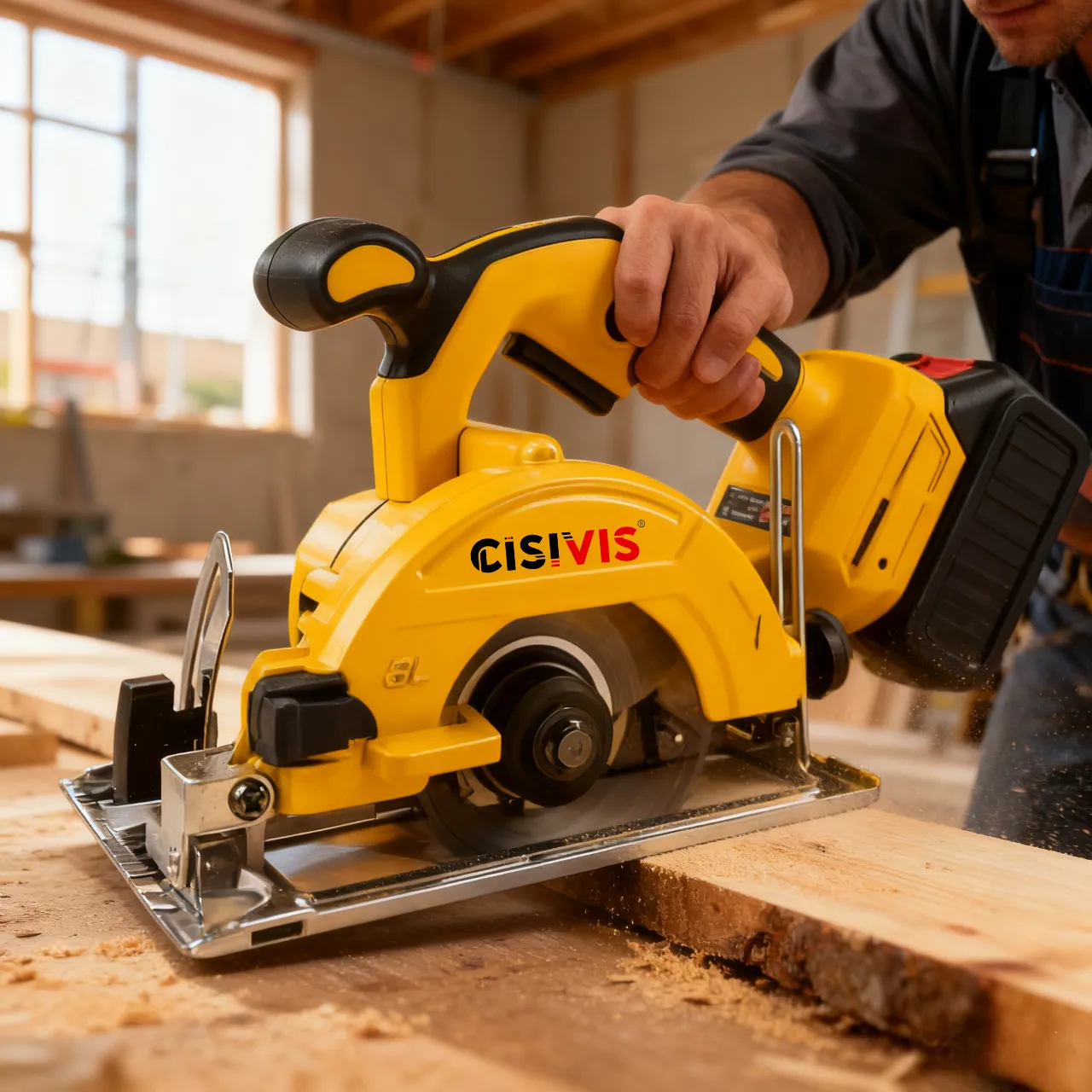The Ultimate Guide to the Cordless Circular Saw – How to Use It Safely, Understand Its Pros & Cons, and Elevate Your DIY Game Leave a comment
What Is a Cordless Circular Saw? Uses and Current Trends
A cordless circular saw is exactly what it sounds like: a circular-saw power tool that runs on a rechargeable battery instead of being plugged into the wall. In simple terms, it’s a handheld saw with a round blade that spins, used to cut wood, plastic, or sometimes metal, and the “cordless” part removes the need for a power cable.
Uses
- Cutting lumber for furniture, shelving, framing, or decking.
- Making straight cuts in plywood, MDF, or boards.
- Trimming sheet goods, or cutting at bevel angles if the saw supports it.
- Job-site work where electrical outlets are inconvenient or there are tripping-hazard cables.
- DIY home improvements: building shelves, cutting boards for home-projects.
Current Trends
The market for cordless circular saws is growing. One report states the global market size for cordless circular saws was about USD 2,151.48 million in 2021, projected to reach USD 2,590.32 million by 2025, and USD 3,754.79 million by 2033, with a compound annual growth rate (CAGR) around 4.75% from 2025 to 2033.
Another source notes that cordless models are becoming more popular due to improved battery technology, lighter weight, and increased portability.
So in short: yes, cordless circular saws are here, they’re getting better, more user-friendly, and are increasingly popular for both professionals and DIYers.

Step-by-Step: How to Use a Circular Saw (for Beginners) + Safety Tips
If you’re new to tools, here’s a straightforward guide to using a cordless circular saw safely and effectively. I’ll walk you through the steps, and highlight what to watch out for.
Step-by-step
- Select the right saw and blade.
- Choose a cordless circular saw that suits your battery voltage/system (for example 18V or 20V).
- Make sure the blade is appropriate for your material (wood, plywood, or metal).
- Check blade diameter and arbor size.
- Prepare your workspace.
- Clear the work area of debris and ensure stable footing.
- Secure the material you are cutting: use clamps so the piece doesn’t move.
- Ensure you have enough space for the saw to move freely and the off-cut to fall safely.
- Check the saw before use.
- Make sure the blade guard is working (it should return after you release trigger).
- Check battery is fully charged or has enough charge for the job.
- Inspect the blade: no missing teeth, not damaged.
- Wear safety gear: eye protection, hearing protection, dust mask if needed, gloves.
- Mark your cut and set depth.
- Use a pencil/marker and straight-edge to mark your cut line.
- On the saw, set the blade depth so the blade sticks out just a little (about 1/4 inch) below the material. This gives efficient cutting and safer operation.
- Position yourself and the saw.
- Stand in a stable way, one foot slightly ahead for balance.
- Hold the saw firmly with both hands (one on the main handle, one on the auxiliary handle if present).
- Ensure the saw’s base (shoe) sits flat on the material and is aligned with your cut line.
- Start the saw and make the cut.
- Align the blade (when spinning) with your cut line, before contacting the material.
- Trigger the saw, then once blade is full speed, gently push forward—don’t force it. Let the blade do the work.
- Keep the saw’s shoe flat and steady; don’t twist it or pull sideways.
- Complete cut and turn off.
- Finish the cut, release the trigger, wait for the blade to stop spinning, then lift the saw away.
- Un-clamp the material and inspect whether the cut is clean or if any splintering occurred.
- After-use care.
- Remove the battery (or unplug if needed), wipe saw clean of dust, inspect blade for wear.
- Store the saw in a dry, safe place; charge batteries as recommended by manufacturer.
Key Safety & Usage Tips (for beginners)
- Never cut free-hand in mid-air; always support the material.
- Don’t stand directly behind the saw in case of kickback (we’ll talk more about this later).
- Avoid cutting glossy or slippery surfaces without proper support.
- Use the correct blade for the material. A wood-cutting blade on metal will damage blade and tool.
- Keep your fingers away from the blade path.
- Don’t force the saw or rush the cut; too fast increases chance of binding or kickback.
- Ensure the battery is charged but not overheated; overheating reduces battery life.
- Change blades when they become dull — a dull blade needs more force and is less safe.
- If you’re outside or in poorly lit area, ensure you have good lighting and stable footing.
By following these steps and tips, even someone with little to no tool experience can use a cordless circular saw safely and efficiently.
Advantages and Disadvantages: Cordless vs. Corded Circular Saws
Here we compare what’s good and not so good about cordless circular saws, and contrast them with traditional corded models.
Advantages of Cordless Circular Saws
- Portability and freedom: No power cord means you can use the saw anywhere – outdoors, remote locations, job sites without easy access to outlets.
- Convenience: Quicker to set up (no cord to untangle, move around).
- Safety: Fewer trip hazards from cords.
- Modern features: Many cordless models include brushless motors, variable speed, better ergonomics, lightweight design (as noted by industry reports).
- Flexibility in system: If you already use a battery-platform (brand’s battery for drills etc), you can often add the saw to your toolset.
Disadvantages of Cordless Circular Saws
- Battery life and power limitations: Even though battery tech is improving, you still must monitor battery status, plan for recharge or spare battery. For heavy, continuous cutting, corded may have advantage.
- Initial cost: Cordless systems can cost more (tool + battery + charger) compared to basic corded models.
- Runtime variability: As battery drains, power may drop, affecting cut quality or speed.
- Weight: Although improving, battery plus tool may be heavier than just a corded model (which has no battery on board).
- Maintenance of battery: You must manage battery health, storage, charging cycles etc.
Corded Circular Saws – Pros & Cons
Pros:
- Continuous power: no battery to worry about; as long as you have outlet you can keep going.
- Often lower cost for basic models.
- Simpler tool (less electronics), sometimes rugged.
Cons:
- Limited by cord length and location of outlet.
- Trip hazard from cord; less convenient for outdoor or remote use.
- Less flexibility for job sites without power or in cramped spaces.
Verdict
If you’re doing DIY around the house, small jobs, or in locations where unplugged mobility helps, a cordless circular saw is likely the better pick. If you’re working day-in, day-out in a fixed location and need maximum continuous power, corded still has its place. The trend is clearly shifting toward cordless thanks to improved battery tech and design.
How to Prevent Kickback in Circular Saw Use & Lifespan Expectations
Preventing Kickback
Kickback is when the saw blade binds or jams and the saw is forced back toward the operator — it’s dangerous. Here are key ways to prevent it:
- Maintain blade depth and correct alignment: A blade set too deep or at wrong angle can bind.
- Keep the base (shoe) of the saw flat on the material: If the shoe rocks or tilts, the blade can bind.
- Use the correct blade for the material and ensure it’s sharp: A dull or incorrect blade is more prone to binding.
- Ensure the material is properly supported and stable: If the cut piece shifts, it can pinch the blade.
- Cut in a straight line, don’t twist or pivot the saw mid-cut: Twisting increases chance of binding.
- Avoid cutting materials that are warped, under tension, or have nails/hardware without proper precautions.
- Stand to the side of the blade path, not directly behind it: In case of kickback, you’re not in line of thrust.
- Always wait for blade to stop before removing tool from material.
- Keep proper pace — don’t force the saw; let it cut at its natural rate.
Lifespan Expectations for a Cordless Circular Saw
While it’s impossible to state a precise number for every tool, here are general expectations:
- A tool like a circular saw (both cordless and corded) — if used and maintained properly — can last 5 to 10 years or more.
- For the battery pack (critical part of cordless) the lifespan is more limited. One source says lithium-ion tool batteries can expect about 1,000 charge cycles (which might translate to 2.7 years if charging every day) under heavy use.
- So realistically: the saw body might last many years given moderate DIY use; the battery may need replacement sooner. Proper care (cool storage, not overcharging, avoiding heat) helps extend both.
Summary & Brand Promotion
In summary: the cordless circular saw is a highly versatile and increasingly popular tool for both DIYers and professionals. It gives you freedom and mobility, especially useful when you’re working in spaces without easy access to outlets. That said, you must use it safely: pick the right blade, secure the material, maintain proper technique, and guard against kickback and other risks. Compare cordless vs corded and choose based on your task, frequency of use, and budget.
Remember: for newcomers to tools, start slow, read the tool’s manual, wear protective gear, and work in a safe environment.
At Cisivis, we offer high-quality cordless circular saws with options for OEM and ODM. You can choose whether to include a digital battery-level display or simple standard version depending on your price-point and branding needs. If you’re looking for a reliable partner for manufacturing or custom branding, let us help you deliver the right tool to the market.



